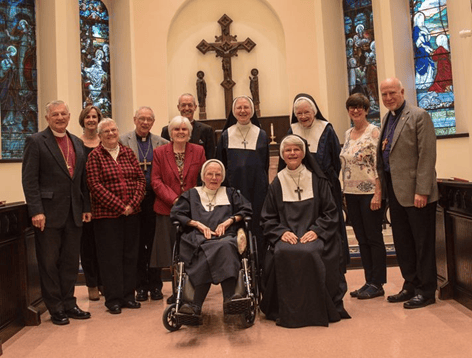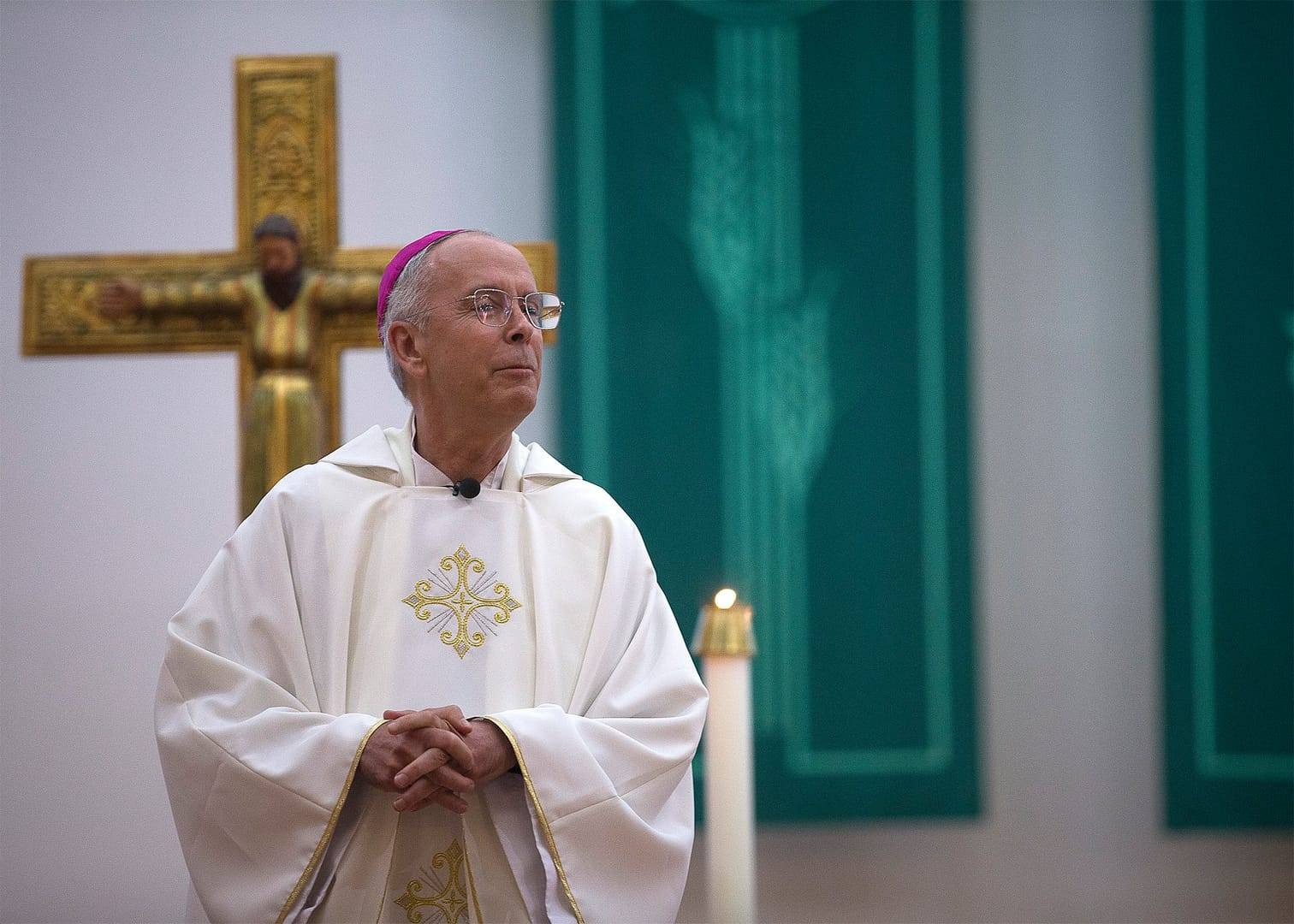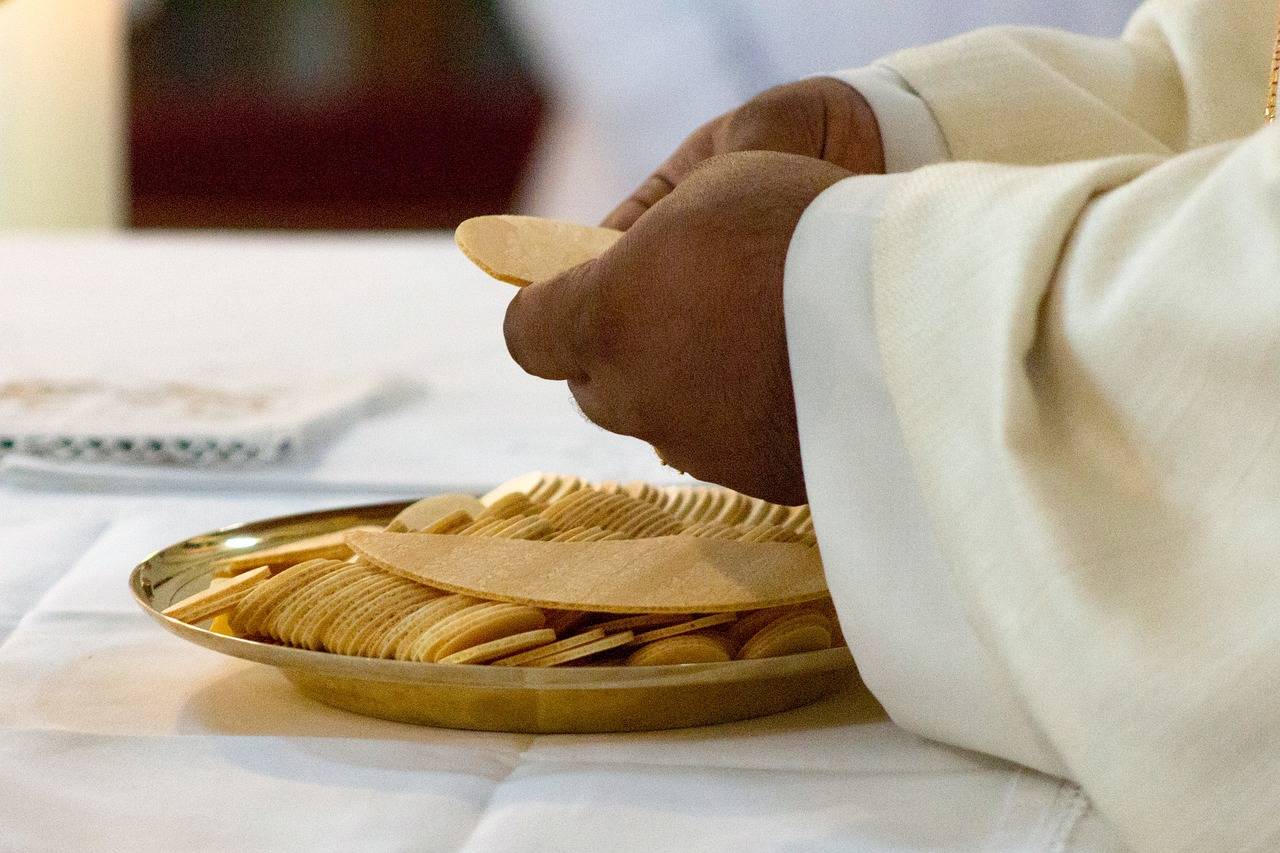BISMARCK, North Dakota — During Mass one recent morning at St. Mary’s Central High School in Bismarck, Father Austin Vetter gave students a challenge.
He told them, when they pray at home, to open themselves up to what Jesus wants for them — and to be prepared for whatever that could entail.
“It may be way different than your own little dream,” he said, then offered an example from his personal life. “I had no idea that I would be bishop.”
He paused for a moment, laughing as he let that last word, “bishop,” sink in.
“It’s crazy,” he said. “I can’t even say it. It’s amazing.”
Vetter, 52, has been a Catholic priest for 26 years. One month ago came a phone call from Archbishop Christophe Pierre, the pope’s ambassador to the United States, wondering whether Vetter would agree to lead the Diocese of Helena in Montana as its next bishop.
He said yes, making him the second priest from the Diocese of Bismarck to be named a bishop, The Bismarck Tribune reported. He follows Sylvester Treinen, who became bishop of Boise, Idaho, in 1962.
Vetter will be installed on Nov. 20 in an Ordination Mass at the Cathedral of St. Helena. It’s a Gothic-style church with tall red spires that serve as a landmark in the city of Helena, nestled in a Rocky Mountain valley. The diocese there spans nearly 52,000 miles of western Montana. It is home to 57 Catholic parishes, as well as 38 missions.
Vetter is making preparations and wrapping up his last few days in Bismarck. He recently celebrated his final Masses at Cathedral of the Holy Spirit, where he is the rector. Father Joshua Ehli, a Bismarck native, will take his place at the Cathedral.
Path to becoming a bishop
Vetter’s name first came up as a candidate to be a bishop in 2013 at the recommendation of Bismarck Bishop David Kagan.
Kagan had put forward his name several times during gatherings of the bishops in the Dakotas and Minnesota.
“He’s a very capable priest, a very holy man,” Kagan said. “That, more than anything else, is what helps bishops be the best possible shepherds to their people they can be.”
Candidates for bishop undergo a thorough vetting process before the pope ultimately selects them. During that time, they have no idea they’re even under consideration.
While Vetter said the call from Pierre a month ago came as a total surprise, he “always knew” he would pursue the priesthood.
Even his parents’ decision to name him Austin offered an early indication.
Ahead of his baptism, his parents sought out the opinion of the priest at the small country church they attended called St. Michael’s, east of Linton. The priest suggested the name Austin, in part because it’s a derivative of Vetter’s father’s name, August.
It also was the name of the priest himself. Father Austin Hermann of St. Michael’s was named after yet another priest who baptized him.
As Vetter recounted that story in his office recently, he said Hermann told his parents, “You never know, you might get a priest out of him.”
Sure enough, they did.
Vetter attended Cardinal Muench Seminary in Fargo and later studied in Rome at the Pontifical North American College and the Pontifical University of St. Thomas Aquinas.
He was ordained at the Cathedral of the Holy Spirit in 1993, where he returned to serve as rector in July 2018. He was previously director of spiritual formation at the Pontifical North American College and has served as pastor at several churches in the Bismarck diocese, including St. Martin’s in Center, St. Patrick’s in Dickinson and St. Leo the Great in Minot. He’s also taught at Creighton University in Nebraska.
Making the priesthood ‘hip’
One of Vetter’s first roles as a priest was at St. Mary’s high school, where he spent more than four years teaching religion to students.
“Day in, day out, they get to see my strengths and my weaknesses, when I’m grouchy, when I’m moody, when I’m happy,” he recalled.
Likewise, he got to see students in a similar light.
“It was very formative for both,” he said. “I became comfortable with young people, and that has never left me.”
Today’s president of Light of Christ Catholic Schools is Vetter’s cousin, Gerald Vetter.
The two grew up spending a lot of time together, both in school and on their families’ farms east of Linton. They even planned to room together in college, until Austin Vetter decided to enter the seminary.
Such an announcement wasn’t as common in those days, as young people were encouraged to take on professions such as teaching or medicine or engineering, Gerald Vetter recalled.
“That was something you didn’t talk about in the ’80s and the ’90s,” he said.
He said his cousin helped change that when he was appointed to teach at St. Mary’s.
“He’s so blatantly blunt and honest that it just became part of the vernacular,” Gerald Vetter said. “I think he made that hip for our diocese.”
When Austin Vetter celebrated Mass at St. Mary’s recently, Father Dominic Bouck, who is the school’s current chaplain, took a moment to tell students about his own experience with the soon-to-be bishop.
Bouck said Vetter used to be his pastor when he was a student.
“He was the one I first went to approach with my thoughts about being a priest,” he said.
Kagan said Bishop Paul Zipfel, who took the helm at the Bismarck diocese in 1997, made a commitment to put at least one young priest in each of the diocese’s three Catholic high schools.
“I think Bishop Zipfel saw what was beginning to happen with Father Vetter at St. Mary’s and a few of the other younger priests,” he said.
Zipfel, Kagan said, “took it to the next level, which has been a tremendous gift to the diocese.”
Preparing for a new role
After Vetter agreed to be bishop, he woke up the morning of Oct. 8, the day the news would become public, and walked into the chapel of the residence where he was staying in Helena.
“I had the most profound time of prayer of my entire life,” he said. “It literally felt like I was in there for five minutes, but it was over an hour. I used to think I knew what the gift of tears were, but I had no idea.”
At that moment, he said, he experienced complete certainty that he was supposed to be moving to Helena and that Jesus had chosen him to be a successor to the apostles — bishops are considered as such in the Catholic faith.
Vetter then felt calm about the role before him.
He added that Pierre, the Pope’s representative, offered some advice — simply to be himself — which has helped put him at ease.
“He said, ‘Austin, Pope Francis chose Austin Vetter. That’s who Jesus wants to be bishop, not someone else,’” Vetter recalled. “He said, ‘If you try to be someone else, you will not like this life. But if you are yourself, you will come to enjoy this life very much.’”
While Vetter prepares for Helena, he has celebrated Mass at various churches around the Bismarck diocese and said goodbye to many familiar faces.
He’s also carved out time to practice one of his new responsibilities: Walking with a tall staff known as a crosier while performing blessings. It can be tricky.
“Your hands start getting all tangled up,” he said.
Kagan has let Vetter borrow his crosier. He acknowledges that, eight years in as bishop in Bismarck, even he still messes up from time to time. But he thinks Vetter will be ready.
“He’s gotten the hang of it very quickly, and he’ll do fine,” Kagan said.
Bishops typically retire at age 75, so Vetter could potentially serve as bishop for 23 years. He was thinking about that as he drove to St. Mary’s to celebrate his last Mass there before he leaves.
He told students that, “in a very real sense, I’m your generation’s bishop.”
“In 23 years, you’re all going to have your lives pretty much set,” he said. “It’s amazing that we’re in this together. We’re not the future of the church; we’re in it now.”
Crux is dedicated to smart, wired and independent reporting on the Vatican and worldwide Catholic Church. That kind of reporting doesn’t come cheap, and we need your support. You can help Crux by giving a small amount monthly, or with a onetime gift. Please remember, Crux is a for-profit organization, so contributions are not tax-deductible.















